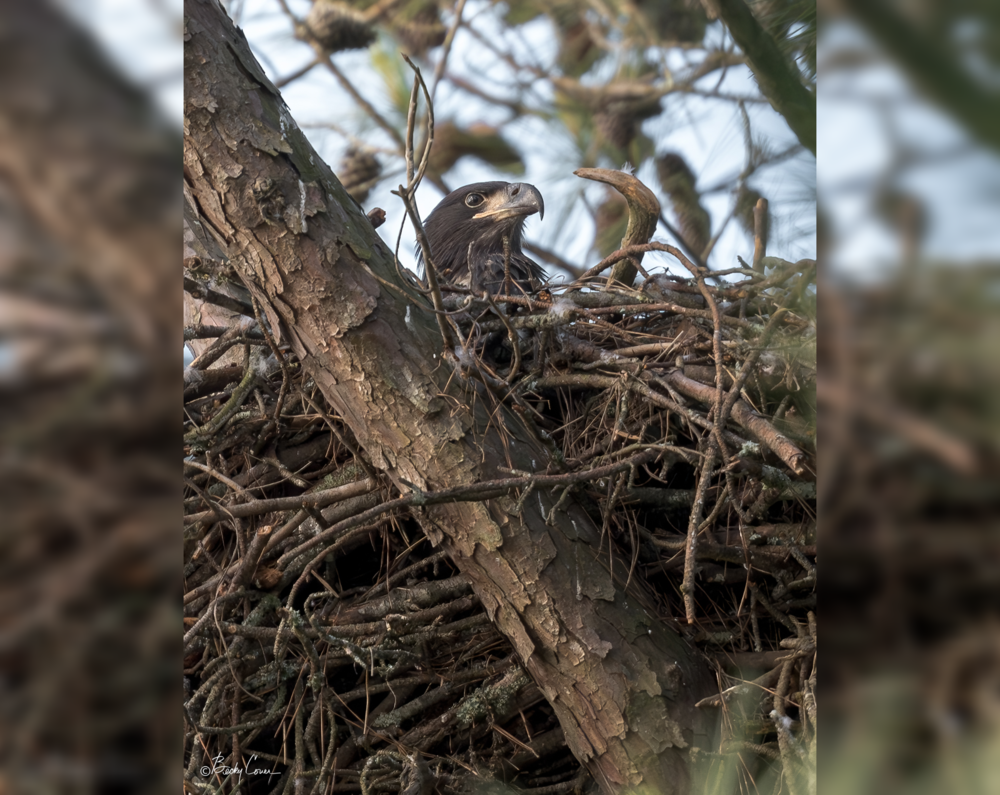
Caption
A juvenile bald eagle is seen in a Piedmont region nest included in the Georgia Department of Natural Resources’ 2024 survey.
Credit: Becky Cover / Georgia Department of Natural Resources

A juvenile bald eagle is seen in a Piedmont region nest included in the Georgia Department of Natural Resources’ 2024 survey.
“Love lift us up where we belong, where the eagles cry on a mountain high.”
When Joe Cocker and Jennifer Warnes sang those famous words in 1982, they just may have been channeling north Georgia in 2024.
That’s because annual surveys of bald eagle nests by the state Department of National Resources found nesting success was above average in most areas checked. And that’s especially good news for patriotic bird fans after illness decimated the population in Georgia two years ago.
“The findings were even better than last year’s good results,” said Georgia Department of Natural Resources survey leader Bob Sargent. “That’s most encouraging when you consider the beating that nesting coastal eagle took in 2022 because of an outbreak of highly pathogenic avian influenza.”
The number of successful nests on the coast dropped about 30% in 2022, and fewer than half of the nests surveyed produced even one eaglet.
But last year, Georgia’s eagles bounced back with strong nest rates, and this year’s survey suggests the rebound is more than just a fluke.
This year’s eagle check, conducted by helicopter, recorded 145 nest territories. Of those, 116 were successful, fledging 178 eagles.
Nest success rates varied from an average of 71% in north/northwest Georgia to an above-average 82% on the coast and in central and northeast Georgia, surveyors found.
On the coast, the 83 nest territories marked the second straight year that total significantly exceeded the average. The 82% nest success rate was also up from 73% last year, with an average of 1.5 young fledged per nest. The total of 99 eaglets fledged from 68 successful nests topped last year’s 89 fledglings and far surpassed the 50 eaglets fledged from only 34 successful nests in 2022, the year of the avian influenza outbreak.
This year’s flyovers covered less territory than the once-every-five-years statewide survey in 2022, but Sargent said accounting for eagle nests not monitored, the totals suggest Georgia has maintained more than 200 nest territories a year since 2015, while the number of eagles nesting here has continued to increase, albeit at a slower rate in recent years.
Still, only 25 years ago the state had no more than about 50 nest territories, Sargent said.
Melanie Furr, director of education at Birds Georgia, said she was thrilled to hear the good eagle news.
“It’s always exciting when you see a bird that’s bouncing back and increasing its numbers, because, as has been sort of widely reported in recent years, most bird populations are in steep decline, so it’s great news about the eagles.”
Eagles were nearly wiped out in the 60s, largely as a result of the pesticide DDT, which entered the food chain and caused thinning of eagle eggshells, preventing them from hatching.
The federal government banned the pesticide in 1972, and Georgia went from no known successful nests during most of the 1970s to one in 1981, 48 by the turn of the century and more than 200 today. The birds were delisted from the endangered species list in 2007.
Life is still hard for eaglets though, and most don’t make it past their first year, Furr said, but those that do can live up to 40 years and amass some seriously impressive real estate.
“They mate for life, and they’ll return to the same nest site year after year, and they’ll refurbish and add to the nest each year. So the nest can grow to huge sizes, like six feet in diameter and up to two tons in weight,” she said. “So when you see really, really big eagles’ nests, that’s probably a pair that’s been returning for many years.”
Mom and dad eagles share in the responsibility of feeding their young, and while fish is their favorite meal, they also dine on other small critters, and they aren’t above scavenging or snatching another bird’s lunch.
“They mostly hunt fish, but they’re also scavengers, which a lot of people don’t realize,” Furr said. “They’ll harass osprey and other birds to get them to drop their fish. I’ve seen them hunting ducks, and of course they’re opportunistic, they would eat anything they could catch, but primarily fish and scavenging is their diet.”
The eaglets will stay in the nest for over three months, and they’ll stay in their parents’ care for several months after leaving, Furr said.
And if you’re hearing extra squawking in your neighborhood, it could be that avian family drama is playing out in your backyard.
“This time of year you’ll start to hear hawks, owls, and I’m sure eagles too, that the young are sort of starting to be cut off by their parents and encouraged to start trying hunting on their own, and often they’ll put up a very vocal protest about it,” Furr said.
Furr said the eagles’ recovery has been a major conservation success story, but like other birds, they still face man-made threats.
“Poisoning is still a concern,” she said. “They do hunt prey other than fish, and lead poisoning from bullets is a continuing problem with birds of prey, as well as rodenticides, any rodents that consume poison and then go out to die in the environment are a threat to eagles and hawks and owls and other wildlife. And of course, just habitat loss, climate change, all these things are affecting bird populations, including eagles.”
This story comes to GPB through a reporting partnership with Georgia Recorder.